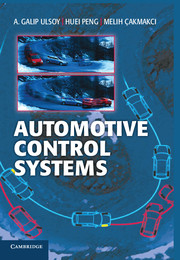Book contents
- Frontmatter
- Contents
- Preface
- Part I Introduction and Background
- 1 Introduction
- 2 Automotive Control-System Design Process
- 3 Review of Engine Modeling
- 4 Review of Vehicle Dynamics
- 5 Human Factors and Driver Modeling
- Part II Powertrain Control Systems
- Part III Vehicle Control Systems
- Part IV Intelligent Transportation Systems
- Appendices
- Index
- References
2 - Automotive Control-System Design Process
Published online by Cambridge University Press: 05 June 2012
- Frontmatter
- Contents
- Preface
- Part I Introduction and Background
- 1 Introduction
- 2 Automotive Control-System Design Process
- 3 Review of Engine Modeling
- 4 Review of Vehicle Dynamics
- 5 Human Factors and Driver Modeling
- Part II Powertrain Control Systems
- Part III Vehicle Control Systems
- Part IV Intelligent Transportation Systems
- Appendices
- Index
- References
Summary
Introduction
Generally, “solving” the controller design problem means finding the proper mathematical representation of a control action that meets a set of desired performance criteria. In reality, this is only one part of the solution (albeit an important part); the control-systems development process also includes steps for selecting the correct hardware – loaded with the proper software – for the controller module, which is the real end-product of this process (Figure 2.1).
The control-system development process begins by first developing the high-level system requirements, which are generally verbal and abstract and rarely point to a recognizable control design problem such as those that traditional engineering students would see in their control classes. The formal and technical requirements documents can be described as “wish lists” regarding the overall system features and performance. The result of the process is the controller module, which is to be deployed in bulk to the end product. The purpose of studying the control-systems development process is to provide a reliable, robust, and repeatable sequence of actions to develop ECUs.
In recent years, computer-aided design and analysis tools (e.g., MATLAB and Simulink) have improved the efficiency of design processes and increased the application of the model-based controller design and development process (Chrisofakis et al. 2011; Mahapatra et al. 2008; Michaels et al. 2010; Powers and Nicastri 2000). Figure 2.2 is a general outline of the model-based controller design and deployment process. The major components of this process (i.e., design, implementation, and testing) are discussed in the next section. The process outline in Figure 2.2 is based on development and testing portions that progress in parallel and continuously interact throughout the development cycle. This is, in fact, one of the most important features of model-based design, which enables debugging and validation of the current work while minimizing changes from the previous phase. Therefore, as the control development evolves, so does the testing platform for its debugging and validation.
- Type
- Chapter
- Information
- Automotive Control Systems , pp. 21 - 32Publisher: Cambridge University PressPrint publication year: 2012

